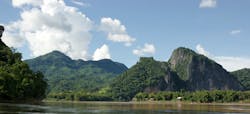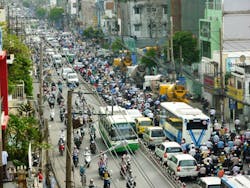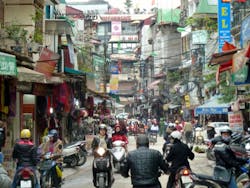Vietnam: Matching Mobile Phone Access To Water And Sanitation
Although Vietnam has achieved steady economic growth over the last two decades, water and sanitation services are still playing catch up. A variety of funders and projects are setting out to improve infrastructure in the country.
By Paul Grad
Over the past 25 years Vietnam has experienced remarkably rapid economic growth, but it still faces great challenges. About 15 million of the country’s 93 million people still live below the national poverty line. Living conditions of many people are still unacceptable by the standards of a developed country.
Access to fresh water and adequate sanitation still present huge development problems. Twenty five years ago about two out of five people in Vietnam did not have access to good quality drinking water, according to the World Health Organization (WHO), and three out of five people did not have access to adequate sanitation.
The country is now closer to bringing drinking water and sanitation to all, but piped water still only reaches 10% of rural households and 60% of urban households. Most Vietnamese receive water from a tap in the yard or from a public tap in the village from where they have to carry the water to their home.
A senior adviser to the Vietnam Ministry of Health, Dr Nguyen Huy Nga, said: “Many people in Vietnam have a motorbike or a mobile phone, but they do not have a toilet. We need to work to change attitudes and beliefs on sanitation.”
The provision of adequate water supply and sanitation in Vietnam stumbles on widespread water pollution, poor service quality, poor sustainability of rural water systems and insufficient cost recovery for urban sanitation. Furthermore, testing by the Vietnam Institute of Biotechnology has revealed widespread contamination of municipal tap water, including high levels of E. coli bacteria and high levels of arsenic.
Ho Chi Minh City
The eight million people in Ho Chi Minh City receive 93% of their drinking water from two treatment plants on the Dong Nai River and the smaller Sai Gon River. The remaining 7% comes from groundwater which is highly polluted. Dong Nai River would have ample water resources but in dry years there may be insufficient drinking water due to competition with water needed for agriculture.
Hanoi, with about seven million people, receives 80% of its water from groundwater which contains five to 10 times higher levels of ammonium than the allowed standard. While ammonium in drinking water is not a direct health risk, it can compromise disinfection efficiency and can cause failure of some filters.
Despite the challenges, however, much has been achieved during the 15 years to 2015 toward the United Nation’s eight Millennium Development Goals (MDG) to meet the needs of the world’s poorest. The 15-year commitment to the MDG has paid off. During those years Vietnam has surpassed the MDG’s targets to reach 82% of the population with improved water and 68% of the population with improved sanitation.
The country has been the recipient of much international aid, mainly from the World Bank, the Asian Development Bank, and from Germany and Japan. It also received aid from Denmark, and the Netherlands.
Active Projects
According to the World Bank’s communications officer in Hanoi, Nguyen Hong Ngan, the World Bank’s largest current water/wastewater project in Vietnam is the US$495 million Second Ho Chi Minh City Environmental Sanitation Project, which was approved in December 2014 and is scheduled for completion in June 30, 2021.
The project consists of four components: a large diameter pipe to convey the wastewater currently discharged into the Saigon River without treatment to a wastewater treatment plant; the wastewater treatment plant; sewerage to complement larger flood protection measures currently planned for the city; and construction supervision.
The World Bank is engaged in several more water/wastewater projects in Vietnam. The Urban Water Supply and Wastewater Project, to be completed in December 2019 at a cost of US$236 million, aims to increase access to sustainable water services and environmental sanitation in selected urban areas. Meanwhile, the Mekong Delta Water Management for Rural Development project aims to protect and enhance the use of water resources in the Mekong Delta. The aim is to sustain gains in agricultural productivity and provide access to water for rural households. The project includes canal dredging, embankment reinforcement, and installation of secondary control sluice gates, with a cost pegged at US$206 million and completion scheduled for March 2017.
The Vinh Phuc Flood Risk and Management Project aims to strengthen flood risk management capacity and improve wastewater management in the central catchment of Vinh Phuc province. The project’s water environment management aims to improve the environmental conditions in densely populated small towns and rural communities, as well as the water quality in the Phan River by providing wastewater and drainage services. Total project cost is US$220 million and completion date is set for December 2021.
Water Efficiency
The Asian Development Bank is involved in a large number of projects in Vietnam involving electric power, transportation, flood protection and other areas of infrastructure.
The ADB’s project titled “Vietnam: Water Efficiency Improvement in Drought Affected Provinces” aims to improve agriculture water productivity by increasing water use efficiency in irrigated agriculture in five drought affected provinces in the Central Highland and South Central Coastal Regions.
It was in late 2015 the ADB approved a loan to expand a water treatment plant on the Da River to supply Hanoi with drinking water, replacing contaminated groundwater. One year later, in 2016 the Hanoi People’s Committee awarded a license to build another water treatment plant on the Duong River west of the city.
European Input
The Vietnamese-German Wastewater Management Program (WMP), implemented by the Gesellschaft fuer Internationale Zusammenarbeit GmbH (Company for International Cooperation Ltd) - GIZ - on behalf of the German Federal Ministry of Economic Cooperation and Development, aims to develop drainage and sewerage in urban centres and industrial parks up to 2025.
The program sets the target for expanding the urban drainage and sewerage system coverage to 70% by 2020 and 80% by 2025. By 2050 it is envisaged that urban flooding will be eliminated and all wastewater will be treated to meet the government’s technical standards.
Earlier this year, the Japan International Cooperation Agency (JICA) signed a grant agreement with the Vietnamese government toward improving the An Duong Water Treatment Plant in Hai Phong City (the country’s third largest city with a population of two million, located in the country’s northeast).
While the city’s water supply rate is higher than 90%, the inflow of household wastewater into the Re River, which is the water source for the plant, results in pollution of the river’s raw water.
To counteract this, large amounts of clarifying agents and chlorine are used, causing problems in the water treatment. This project aims to stabilise the operation of the plant and reduce the amount of chlorine used, improving the supply of drinking water to the city dwellers.
The Dutch government will co-finance a project for construction of a new wastewater treatment plant and a connecting sewerage system in Phu My (the port city for Ho Chi Minh City, about 120km away).
The plant and sewerage system will treat the wastewater of 174,000 people and industrial wastewater. The treatment system will apply Carrousel technology from the Dutch company Royal HaskoningDHV, using an oxidation ditch shaped as a looped channel. According to the company the continuous biological/process of biological oxygen demand (BOD) removal and simultaneous nitrification and denitrification in a single reactor, requiring only limited equipment.
The Danish International Development Agency (DANIDA) has just launched a training program for staff of six wastewater treatment and clean water supply projects in Vietnam. Denmark has offered financial and technical assistance to many projects in Vietnam relating to infrastructure development and water pollution.
According to AWDO 2016: “Asia cannot sustain economic growth unless water is brought into the equation. Water insecurity costs the global economy US$500 billion annually with a total drag of 1% or more of global gross domestic product. Meeting the socioeconomic challenges of the region will require going beyond infrastructure-centric solutions to consider the status of water resources and water service provision.”
Paul Grad is a freelance correspondent for WWi magazine, based in Australia.
More Water & WasteWater International Archives Issue Articles



